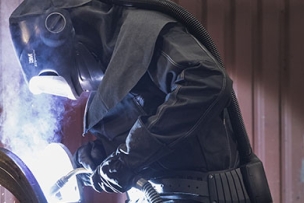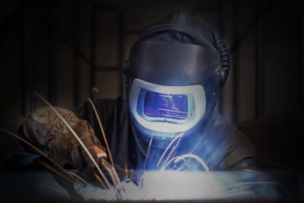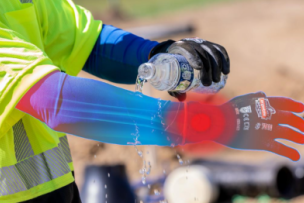Products that work as hard as you do. From the most basic to the most specialized needs, 3M offers the health and safety protection you and your workers need most, so everyone can perform at their best. We strive to deliver comfortable, well-designed personal protective equipment (PPE) that offers your workers the most effective protection available.
Coughing, hacking, phlegm, even things like ‘black snot’. These are real things that you are likely all-too-familiar with if you work in or around welding. If you’ve been welding a long time, or spend much time around welders, you may think these are normal effects from welding. That it’s your body’s way of keeping impurities out. However, this is not normal.
A good health and safety program will initially try to use engineering controls (like local exhaust ventilation “LEV”) to control a contaminant. However, with welding, these controls may not be feasible or completely effective. Thus, wearing a respirator may be necessary to help protect you from welding fumes.
If you are not wearing a respirator, or have not been properly medically evaluated, trained or fitted and are using respiratory protection, there is still a chance you are breathing in welding fume. But, the burning that causes smoke and fumes may be more hazardous than you think.
What is Welding Fume?
When you weld, you generate so much heat that you actually vaporize the metal. As soon as the metal vapor leaves the heat of the arc, it recondenses back into an extremely small particle called a “fume”. These microscopic bits of hot metal are small enough and buoyant enough to be released from the welding arc and rise in a cloud of metal fume into workplace air. These fumes can then be inhaled by the welder or others close to the source. The effects of welding fume are not typically immediately obvious, like heat that can burn your skin or radiation that can affect your eyes.

The visible part of the fume cloud is mainly particles of metal, metal oxides and flux (if used). The science around welding fumes is evolving and the exact level of risk and the different toxic effects from the fume will depend on what metals (and their concentrations) are involved in the work. There are many different metals that workers may be exposed to, such as:
• Beryllium
• Manganese
• Chromium (including hexavalent chromium Cr VI)
• Iron
• Aluminum
• Cadmium
• Nickel
• Copper
• Lead
• Zinc
• and others
Because each of these metal fumes can have a different effect on the body, exposure should be effectively controlled. If effective engineering controls are not in place, or just are not practical at the job site, there can be significant exposures to workers and this can potentially lead to health effects.
For instance, workers may develop metal fume fever that presents as flu-like symptoms and lasts 24-48 hours. Additionally, short-term exposures to significant levels of welding fumes and gases can result in eye, nose and throat irritation, dizziness and nausea, which is also commonly known as Welder’s sickness. Long-term overexposure to welding fume can cause lung damage and other serious health effects. Again, the science behind understanding the effects of welding fume is evolving.
OSHA has reevaluated some of the acceptable levels of different metals that are found in welding fume, such as hexavalent chromium. OSHA has lowered the acceptable levels of these metals considerably, which is another indication that respiratory protection choices should be reevaluated to ensure you are making choices that will provide adequate protection and comply with these lowered levels.
Overexposure to welding fume may also be hazardous to bystanders such as welder helpers, employees conducting fire watches or workers located adjacent to welding operations. A hazard assessment should be conducted and appropriate precautions must be taken to ensure health and safety. Employers should update exposure assessments for welding fumes, including welders and nearby workers who are not engaged in welding but may be exposed to welding fumes.
Metalworking Respiratory Personal Protective Equipment Recommendations
You should also think about respiratory hazards the same way that you automatically do for other PPE/protection you already use. While arc/UV radiation and burn potential from welding are immediately obvious, protecting your lungs and other vital organs is also essential.
Exposure assessments identifying varying hazards will require different PPE solutions with specific fit-testing and inspection requirements. As you add safety equipment to your work gear, you may find increased convenience from an integrated protection solution, which can potentially provide protection for multiple hazards in your application. For welders, this could be welding helmets that have auto-darkening filters, hard-hat protection, integrated grinding shields for eye hazards and mountable earmuffs for noisy environments. Some solutions also integrate a powered air purifying respiratory (PAPR) system. Some of these options may even allow for facial hair.
When you conduct exposure assessments in the workplace and identify the presence of a respiratory hazard, you need to implement a written respiratory protection program that meets all the requirements of 29 CFR 1910.134. Additionally, as OSHA requirements and exposure levels change, you need to review and update your program. 3M's Center for Respiratory Protection has a wide variety of resources to help you, including information to help you conduct your assessment and select the products you need to help protect against the hazards you are exposed to at your work site.
Since metalworking hazards include many different types of welding fume materials, picking the appropriate respiratory protection as part of your metal/fabrication PPE choices is crucial. If you are interested in a demonstration of any of 3M's products, including their integrated PAPR solution, contact them today.
Previously Featured on 3M's blog.
Browse MSCDirect.com for respiratory protection from 3M.









Talk to Us!
Leave a reply
Your email address will not be published. Required fields are marked *